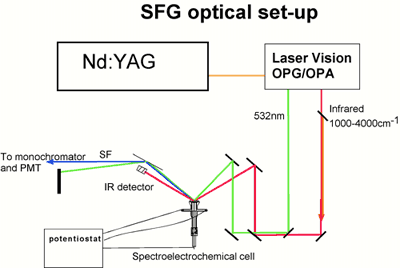Faculty Profile
 Steven Baldelli
Steven Baldelli
Professor
Department of Chemistry
Office: SERC, 1024
Contact: sbaldelli@uh.edu - 832-842-8843
Education: Ph.D., Tufts University, 1998; B.S., Framingham State College, 1992
Surface Chemistry
Our research interest is in the field of physical chemistry, specifically adsorption and reactions of molecules at the solid–liquid electrochemical interface. These areas of chemistry represent some of our broad research interests. We will use surface specific laser spectroscopy to gain information about how molecules behave at the electrified interface. The goal will be to bring a molecular perspective to these systems to advance this field. This area overlaps with many subfields in physical chemistry, such as electrochemistry, photochemistry, surface chemistry, and materials science. The applications are widely varied from solar cells, photocatalysis, and environmental remediation to biomaterials, corrosion, and energy conversion (fuel cells). Our group has specific research projects in each of these areas.
Surface Electrochemistry
Electrochemistry is an effective method to control adsorption and reactions at the solid-liquid interface. When electrochemical measurements are combined with spectroscopic probes, an unprecedented amount of knowledge is obtained. This approach will be used to study organic monolayers on a copper electrode since this serves as a model system to test corrosion inhibitors.
Until recently, these interfaces were inaccessible to molecule specific techniques due to the obscuring effect of bulk solution. The development of nonlinear spectroscopy and scanning probe techniques significantly improved our access to these systems. Although there is a wealth of macroscopic information on these interfaces, there is a distinct lack of molecular level detail, which inhibits our understanding of the chemistry that occurs there. By choosing specific systems that broadly model large classes of interfaces, our goal is to correlate the microscopic information with the macroscopic properties, thus providing an essential view of the behavior of molecules at these surfaces. We will use SFG in conjunction with ECM (electrochemical microscopy) and electrochemical methods to develop a more complete description of the system.
Laser Spectroscopy
The main techniques we use are nonlinear optical spectroscopies, specifically sum frequency generation (SFG) and second harmonic generation (SHG). These spectroscopic methods have the advantage of being sensitive only to the interface between two bulk media, thus allowing us to investigate the surface region without interference from bulk phase molecules. Further, SFG provides a vibrational spectrum of the surface molecules, which is useful in determining the orientation and chemical environment of the interfacial molecules.

- Postdoctoral fellow University of California, Berkeley
- Visiting Professor Royal Institute of Technology, Stockholm